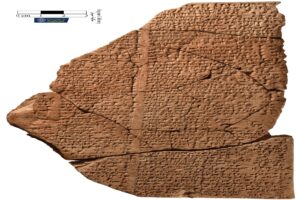Ancient Romans widely held superstitions involving nails. And researchers think a special set of 41 bent, headless, or twisted nails at one cremation site fulfilled a chilling role.
Archaeologists working at Sagalassos in Turkey excavated the grave, which dates to the second century AD. Listing multiple examples of ways Romans used nails to protect themselves from unrest both spiritually and corporeally, the researchers said the 41 nails were likely “intended to protect the deceased from evil in the afterlife or to prevent the dead from harming the living.”
The paper, published recently in the journal Antiquity, calls the cremation “non-normative” — the nails aren’t the only thing potentially talismanic about it.
The study also found that bricks were arranged on top of the still-smoldering remains, then covered with a lime mixture that hardened. The bricks’ placement on the pyre was not to safeguard the cremains for future recovery, which was typical for cremations at Sagalassos.
Instead, sealing the pyre site “effectively transformed its location into a permanent tomb for the cremains,” the paper said. Romans sometimes used weights “in an attempt to immobilize the physical remains of a potential revenant” (one who returns from the dead).

The cremation site (flat layer of bricks at right of photos) in two stages of excavation, next to two tombs constructed later (left of both photos). Photo: Sagalassos Archaeological Research Project
Evidence suggests occult burial
Archaeologists recovered over 50 bone fragments, likely from an adult male. Other charred remnants showed normal burial items like jars that contained walnuts, grapes, and almonds, and a shroud or article of clothing. A coin dating roughly to the time of the burial turned up among the cranial fragments. And an “unidentifiable worked bone item with bronze hinges” was also at the site.

Skull fragments from the burial included pieces of the cranium and jaw. Photo: Sagalassos Archaeological Research Project
The grave’s position also suggests occult associations.
It’s in a “peri-urban” area located northeast of the main city center, on a raised, bowl-shaped plateau.
“Its somewhat secluded location…[where] their inherent nuisances, dangers, and taboos could effectively be kept out of the central and residential quarters of the city,” the authors wrote.

Photo: Sagalassos Archaeological Research Project
Generally, using nails to ward off ills was not taboo in Roman culture. Pliny the Elder, confidant of the Emperor Vespasian and an early chronicler of natural history, recommended “fixing nails from tombs into a threshold” for protection against nightmares, the paper said. He also claimed an iron nail could cure epilepsy if driven into the ground where the patient’s head first touched it. And Livy, who wrote the first history of Rome, noted that “a pestilence had once been assuaged by the dictator driving in a nail.”
Researchers think that the nails at the Sagalassos grave cannot have served a practical purpose. Along with their intentional deformation, they wouldn’t have belonged at a Roman funeral pyre, which required no construction.

Comparing the apparently ritualistic nails (left) to nails from coffins found nearby. Photo: Sagalassos Archaeological Research Project
‘Intent on retaliation’
The upshot (according to the paper): Those who performed the man’s funeral rites saw fit to scatter talismans that could protect either him or them from malevolence. At the same time, it created a distinct boundary between themselves and him, in a place typically reserved for clandestine acts.
But various signals of respect typically rendered to the dead also appear: vessels with traditional foods, and the possible shroud.
“Caution is obviously needed when venturing to reconstruct the motivations of the mourners, but they appear to have followed most of the rites associated with a normative burial, while simultaneously shielding the community from any possible harm from the restless dead, using nails, bricks and lime,” the authors advised.
They also point out that ancient burials often included lime as a way to ward off disease. The authors also cited Fritz Graf, a renowned scholar of ancient Mediterranean magic practices, who found that magically oriented burials could follow supposedly supernatural deaths.
The paper’s authors did not shy away from a decisive stance. Considering the overall burial circumstances led them to an unearthly conclusion.
“Regardless of whether the cause of death was traumatic, mysterious, or potentially the result of a contagious illness or punishment, it appears to have left the dead intent on retaliation and the living fearful of the deceased’s return.”
A ritualistic Roman zombie entombment? Welcome to Monday on ExplorersWeb.






